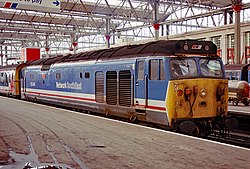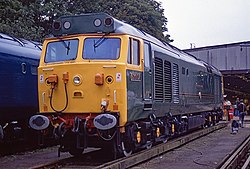British Rail Class 50
The British Rail (BR) Class 50 is a diesel locomotive built from 1967–68 by English Electric at their Vulcan Foundry Works in Newton-le-Willows. Fifty of these locomotives were built to haul express passenger trains on the, then non-electrified, section of the West Coast Main Line between Crewe, Carlisle and Scotland. They were originally hired from English Electric Leasings, not being purchased outright by BR until around 1973. Under the pre-1968 classification system these locomotives were known as the English Electric Type 4. The class were affectionately nicknamed "Hoovers" by rail enthusiasts because of their distinctive engine sound, caused by the centrifugal air filters originally fitted. These proved unreliable, and were later removed, but the "Hoover" nickname stuck.
| British Rail Class 50 | |

| |
| 50049 Defiance at Bath Spa Station on 3 June 2007. | |
| Power type | Diesel-electric |
|---|---|
| Builder | English Electric at Vulcan Foundry |
| Build date | 1967–1968 |
| Total production | 50 |
| Configuration | Co-Co |
| UIC classification | Co'Co' |
| Gauge | Lua error in package.lua at line 80: module 'Module:Track gauge/data' not found. |
| Wheel diameter | 3 ft 7 in (1.092 m) |
| Wheelbase | 56 ft 2 in (17.12 m) |
| Length | 68 ft 6 in (20.88 m) |
| Width | 8 ft 10 in (2.69 m) |
| Height | 12 ft 9 in (3.89 m) |
| Locomotive weight | 115 long tons (117 t) |
| Prime mover | English Electric 16 CSVT |
| Multiple working | ■ Orange Square |
| Top speed | 105 mph (169 km/h) |
| Power output | Engine: 2,700 bhp (2,010 kW) |
| Tractive effort | Maximum: 48,500 lbf (216 kN) Continuous: 33,000 lbf (147,000 N) |
| Train heating | Electric Train Heat |
| Train brakes | Dual (Air and Vacuum) |
| Career | British Rail |
| Number | D400–D449; later 50001–50050 |
| Axle load class | Route availability 6 |
British Rail Class 50 Media
D438 (later 50038) at Carlisle Citadel station in October 1973
50043 Eagle hauling the morning express across the Penadlake viaduct on 29 August 1987









